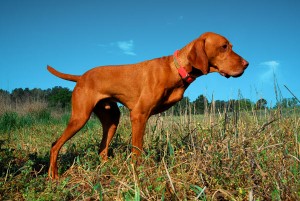As we get ready for Natasha's operation tomorrow to remove a curious tumor-like growth on her back for biopsy this story gives me great strength and hope. With any luck Natasha Rose's growth will be nothing and she will be in fine show shape by July when we hope to have her in her first international show.
We have subscribed to the Gun Dog magazine and are thrilled to learn that our first copy to arrive in Chile by August will have Bart the wonder dog on its cover:
I encourage you all to read the article online and
order your copy of the magazine available on news stands July 3.
Learn more about Cancer and lymphoma for your vizsla here:
Click on the type of cancer for more information
Vizsla owners can help by participating in research
Canine Comparative Oncology and Genomics Consortium (CCOGC)
The CCOGC collects tissues and fluids from dogs with specific cancer types following strict SOPs. These procedures ensure all samples are of high quality and can be used consistently across multiple research projects. The samples are
assessable to any research project with scientific merit. You can learn more about CCOGC and find a collection site near you at the
CCOGC website.
Clinical Trials
If your dog has recently been diagnosed with a disease, there may be a clinical trial in your area investigating a treatment for that disease. Enrolling in a clinical trial brings with it a commitment to follow through on therapies and testing. The benefits can include access to cutting edge medicine and the chance to help future generations of dogs.
Resources for finding clinical trials.
Request for Cheek Swab Samples from the Canine Hereditary Cancer Consortium
Below is a request for Vizsla cheek swab samples from the Canine Hereditary Cancer
Consortium (CHCC). This cancer study includes Vizslas and is focused on Lymphoma
and Melanoma. The CHCC also needs healthy non-affected Vizsla cheek swab samples
to be controls. Samples submitted by VCA members would greatly assist this study.
Please read the information from Dr. Roe Froman DVM below. Dr. Froman is also the
Health Chairman for the Clumber Spaniel Club of America.
Dr. Froman has also been able to access the Vizsla Lymphoma samples sent to the
Canine Health Information Center (CHIC) DNA Repository that were obtained years ago
through efforts of the Magyar Vizsla Society and its members. Dr Froman has found
Vizsla Lymphoma samples to be very useful in this study.
I would like to thank the vizsla owners who generously submitted their Vizslas’ blood
samples to the Magyar Vizsla Society, some as long as almost 15 years ago. It is very
gratifying to see that cancer researchers are now finally utilizing these Lymphoma
samples. I would also like to thank the Magyar Vizsla Society and its past membership as
well as Sue Boggs who was the past liaison for Vizsla owners to submit their paperwork
and information. Hopefully, these Vizslas affected by Lymphoma years ago are now able
to help future Vizslas and other breeds as well. Again, thank you to the Vizsla owners
who believed in this project long before we had CHIC and Canine DNA Data Banks.
To assist this important research, please share this information with Regional Clubs to be
posted on their web sites and newsletters. Also, please support the CHIC DNA
Repository. More information regarding CHIC’s DNA Repository is available at:
www.caninehealthinfo.org/dnabank.html
Thank you,
Lynda Ruffini
Vizsla Club of America
Chair, Health Committee
thebirdhuntress@stny.rr.com
Request for Cheek Swab samples for the CHCC
The CHCC (Canine Hereditary Cancer Consortium) is an unprecedented alliance of
researchers, veterinarians, physicians and dog owners who are taking advantage of new
genetic resources and technologies to learn how the DNA of dogs affected with cancer
varies from that of the DNA of healthy, unaffected dogs. No dogs are kept for research;
we use only samples from dogs with naturally occurring disease. This research is funded
by the National Cancer Institute as well as by corporate sponsorship.
Vizslas are currently included in two of our studies: melanoma and lymphoma. Samples
from affected dogs stored at the CHIC repository have been utilized, along with samples
submitted by Vizsla owners directly from their affected dogs. All samples are strictly
confidential; no identifying information about dogs or owners is ever released or
published. We also need samples from healthy Vizslas who do NOT have either melanoma or
lymphoma, to serve as controls. We will be happy to send buccal (cheek brush) DNA
collection kits at owners’ request. The kits are very user friendly, easy to do at home, and
include prepaid return mailers.
To participate in the study, please email the following information to Dr. Roe Froman
DVM (roe.froman@vai.org):
Owner’s name:
Address:
Email:
Names of your pure bred vizslas available for cheek swab sampling
Your participation is needed to help us develop new genetic screens, diagnostic tests, and
treatments for canine cancers, as well as helping us to gain insight into the biology of
human disease. Your help will be greatly appreciated.





























